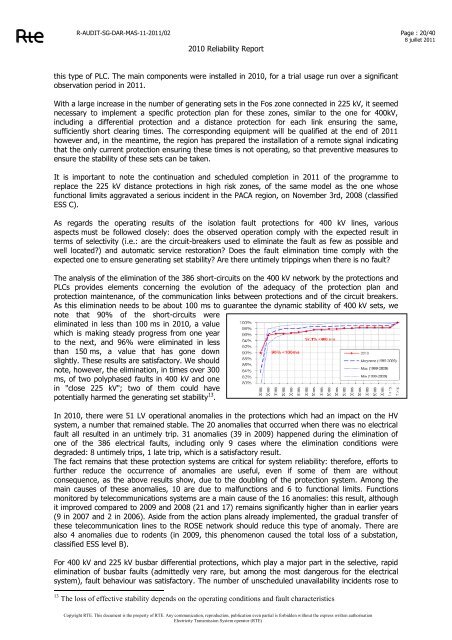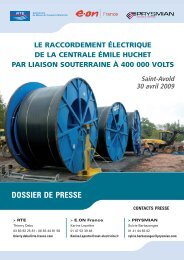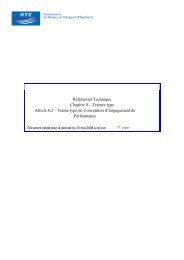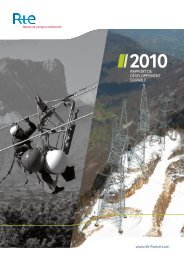Power System Reliability Report - RTE
Power System Reliability Report - RTE
Power System Reliability Report - RTE
- No tags were found...
Create successful ePaper yourself
Turn your PDF publications into a flip-book with our unique Google optimized e-Paper software.
R-AUDIT-SG-DAR-MAS-11-2011/022010 <strong>Reliability</strong> <strong>Report</strong>Page : 20/408 juillet 2011this type of PLC. The main components were installed in 2010, for a trial usage run over a significantobservation period in 2011.With a large increase in the number of generating sets in the Fos zone connected in 225 kV, it seemednecessary to implement a specific protection plan for these zones, similar to the one for 400kV,including a differential protection and a distance protection for each link ensuring the same,sufficiently short clearing times. The corresponding equipment will be qualified at the end of 2011however and, in the meantime, the region has prepared the installation of a remote signal indicatingthat the only current protection ensuring these times is not operating, so that preventive measures toensure the stability of these sets can be taken.It is important to note the continuation and scheduled completion in 2011 of the programme toreplace the 225 kV distance protections in high risk zones, of the same model as the one whosefunctional limits aggravated a serious incident in the PACA region, on November 3rd, 2008 (classifiedESS C).As regards the operating results of the isolation fault protections for 400 kV lines, variousaspects must be followed closely: does the observed operation comply with the expected result interms of selectivity (i.e.: are the circuit-breakers used to eliminate the fault as few as possible andwell located?) and automatic service restoration? Does the fault elimination time comply with theexpected one to ensure generating set stability? Are there untimely trippings when there is no fault?The analysis of the elimination of the 386 short-circuits on the 400 kV network by the protections andPLCs provides elements concerning the evolution of the adequacy of the protection plan andprotection maintenance, of the communication links between protections and of the circuit breakers.As this elimination needs to be about 100 ms to guarantee the dynamic stability of 400 kV sets, wenote that 90% of the short-circuits wereeliminated in less than 100 ms in 2010, a valuewhich is making steady progress from one yearto the next, and 96% were eliminated in lessthan 150 ms, a value that has gone downslightly. These results are satisfactory. We shouldnote, however, the elimination, in times over 300ms, of two polyphased faults in 400 kV and onein "close 225 kV"; two of them could havepotentially harmed the generating set stability 13 .In 2010, there were 51 LV operational anomalies in the protections which had an impact on the HVsystem, a number that remained stable. The 20 anomalies that occurred when there was no electricalfault all resulted in an untimely trip. 31 anomalies (39 in 2009) happened during the elimination ofone of the 386 electrical faults, including only 9 cases where the elimination conditions weredegraded: 8 untimely trips, 1 late trip, which is a satisfactory result.The fact remains that these protection systems are critical for system reliability: therefore, efforts tofurther reduce the occurrence of anomalies are useful, even if some of them are withoutconsequence, as the above results show, due to the doubling of the protection system. Among themain causes of these anomalies, 10 are due to malfunctions and 6 to functional limits. Functionsmonitored by telecommunications systems are a main cause of the 16 anomalies: this result, althoughit improved compared to 2009 and 2008 (21 and 17) remains significantly higher than in earlier years(9 in 2007 and 2 in 2006). Aside from the action plans already implemented, the gradual transfer ofthese telecommunication lines to the ROSE network should reduce this type of anomaly. There arealso 4 anomalies due to rodents (in 2009, this phenomenon caused the total loss of a substation,classified ESS level B).For 400 kV and 225 kV busbar differential protections, which play a major part in the selective, rapidelimination of busbar faults (admittedly very rare, but among the most dangerous for the electricalsystem), fault behaviour was satisfactory. The number of unscheduled unavailability incidents rose to13 The loss of effective stability depends on the operating conditions and fault characteristicsCopyright <strong>RTE</strong>. This document is the property of <strong>RTE</strong>. Any communication, reproduction, publication even partial is forbidden without the express written authorisationElectricity Transmission <strong>System</strong> operator (<strong>RTE</strong>)
















